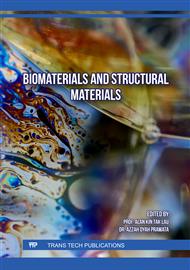[1]
A. Salimi, and S. Sanjabi, Infiltration brazed core-shell WC@NiP/NiCrBSi composite cladding, Surface and Coatings Technology 352 (2018) 59-73.
DOI: 10.1016/j.surfcoat.2018.08.001
Google Scholar
[2]
L. Han, S. Zheng, M. Tao, C. Fei, Y. Hu, B. Huang, and L. Yuan, Service damage mechanism and interface cracking behavior of Ni-based superalloy turbine blades with aluminized coating, International Journal of Fatigue 153 (2021) 106500.
DOI: 10.1016/j.ijfatigue.2021.106500
Google Scholar
[3]
P. Forsberg, P. Hollman, and S. Jacobson, Wear mechanism study of exhaust valve system in modern heavy duty combustion engines, Wear 271(9) (2011) 2477-2484.
DOI: 10.1016/j.wear.2010.11.039
Google Scholar
[4]
J. Fiebig, E. Bakan, T. Kalfhaus, G. Mauer, O. Guillon, and R. Vaßen, Thermal Spray Processes for the Repair of Gas Turbine Components, Advanced Engineering Materials 22(6) (2020) 1901237.
DOI: 10.1002/adem.201901237
Google Scholar
[5]
S.A. Galedari, A. Mahdavi, F. Azarmi, Y. Huang, and A. McDonald, A Comprehensive Review of Corrosion Resistance of Thermally-Sprayed and Thermally-Diffused Protective Coatings on Steel Structures, Journal of Thermal Spray Technology 28(4) (2019) 645-677.
DOI: 10.1007/s11666-019-00855-3
Google Scholar
[6]
R.K. Guduru, U. Dixit, and A. Kumar, A critical review on thermal spray based manufacturing technologies, Materials Today: Proceedings 62 (2022) 7265-7269.
DOI: 10.1016/j.matpr.2022.04.107
Google Scholar
[7]
D. Pierce, A. Haynes, J. Hughes, R. Graves, P. Maziasz, G. Muralidharan, A. Shyam, B. Wang, R. England, and C. Daniel, High temperature materials for heavy duty diesel engines: Historical and future trends, Progress in Materials Science 103 (2019) 109-179.
DOI: 10.1016/j.pmatsci.2018.10.004
Google Scholar
[8]
M. Aliabadi, F. Khodabakhshi, R. Soltani, and A.P. Gerlich, Modification of flame-sprayed NiCrBSi alloy wear-resistant coating by friction stir processing and furnace re-melting treatments, Surface and Coatings Technology 455 (2023) 129236.
DOI: 10.1016/j.surfcoat.2023.129236
Google Scholar
[9]
H.Y. Zhang, C.X. Li, S.H. Liu, L. Li, G.J. Yang, C.J. Li, and S.L. Zhang, Splash involved deposition behavior and erosion mechanism of long laminar plasma sprayed NiCrBSi coatings, Surface and Coatings Technology 395 (2020) 125939.
DOI: 10.1016/j.surfcoat.2020.125939
Google Scholar
[10]
F.S.K. Tabatabaei, B. Ghasemi, O. Mirzaee, and E. Adabifiroozjaei, The effect of WC-CoCr content on hardness and tribological properties of NiCrBSi coatings fabricated by the HVOF process, Surface and Coatings Technology 466 (2023) 129506.
DOI: 10.1016/j.surfcoat.2023.129506
Google Scholar
[11]
X. Liu, K. Hu, S. Zhang, T. Xu, L. Chen, E. Byon, and D. Liu, Study of KCl-induced hot corrosion behavior of high velocity oxy-fuel sprayed NiCrAlY and NiCrBSi coatings deposited on 12CrMoV boiler steel at 700 ℃, Corrosion Science 203 (2022) 110351.
DOI: 10.1016/j.corsci.2022.110351
Google Scholar
[12]
E. Qin, B. Wang, W. Li, W. Ma, H. Lu, and S. Wu, Optimized Microstructure and Properties of Cr3C2-NiCr Cermet Coating by HVOF/Laser Hybrid Processing, Journal of Thermal Spray Technology 28(5) (2019) 1072-1080.
DOI: 10.1007/s11666-019-00877-x
Google Scholar
[13]
S. Masood Arif Bukhari, N. Husnain, F. Arsalan Siddiqui, M. Tuoqeer Anwar, A. Abbas Khosa, M. Imran, T. Hassan Qureshi, and R. Ahmad, Effect of laser surface remelting on Microstructure, mechanical properties and tribological properties of metals and alloys: A review, Optics & Laser Technology 165 (2023) 109588.
DOI: 10.1016/j.optlastec.2023.109588
Google Scholar
[14]
L. Yang, X. Shi, X. Tian, X. Han, J. Mu, and L. Qi, Effect of sealing treatment on corrosion behavior of plasma sprayed ZrO2 coated Cf/Mg composites, Surface and Coatings Technology 423 (2021) 127627.
DOI: 10.1016/j.surfcoat.2021.127627
Google Scholar
[15]
X.C. Yang, G.L. Li, H.D. Wang, T.S. Dong, and J.J. Kang, Effect of flame remelting on microstructure and wear behaviour of plasma sprayed NiCrBSi-30%Mo coating, Surface Engineering 34(3) (2018) 181-188.
DOI: 10.1080/02670844.2016.1226053
Google Scholar
[16]
K.A. Habib, D.L. Cano, J.A.H. Alvaro, J. Serrano-Mira, R. Llopis, D.L. Moreno, and S.S. Mohammed, Effects of thermal spraying technique on the remelting behavior of NiCrBSi coatings, Surface and Coatings Technology 444 (2022) 128669.
DOI: 10.1016/j.surfcoat.2022.128669
Google Scholar
[17]
Y.Z. Wu, W.B. Liao, F. Wang, M.L. Wang, C.Y. Yu, Z. Wang, Z.X. Guo, Z.Y. Liu, Y.B. Cao, and J.J. Huang, Effect of electron beam remelting treatments on the performances of plasma sprayed zirconia coatings, Journal of Alloys and Compounds 756 (2018) 33-39.
DOI: 10.1016/j.jallcom.2018.05.004
Google Scholar
[18]
T. Dong, L. Liu, G. Li, R. Wang, J. Yuan, and Y. Feng, Effect of induction remelting on microstructure and wear resistance of plasma sprayed NiCrBSiNb coatings, Surface and Coatings Technology 364 (2019) 347-357.
DOI: 10.1016/j.surfcoat.2019.02.083
Google Scholar
[19]
G.L. Li, Y.L. Li, T.S. Dong, B.G. Fu, H.D. Wang, X.D. Zheng, and X.K. Zhou, Microstructure and interface characteristics of NiCrBSi thick coating remelted by TIG process, Vacuum 156 (2018) 440-448.
DOI: 10.1016/j.vacuum.2018.07.020
Google Scholar
[20]
N. Serres, F. Hlawka, S. Costil, C. Langlade, F. Machi, and A. Cornet, Combined plasma spray and in situ laser melting treatment of NiCrBSi powder, Journal of Optoelectronics and Advanced Materials 12 (2010) 505-510.
DOI: 10.1007/s11666-010-9565-1
Google Scholar


